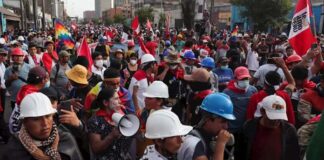Millions of Colombians, at times up to 10 per cent of the population, have been on the streets for over a month against attempts to make ordinary people pay for the costs of the COVID crisis by the right-wing government of President Ivan Duque.
The revolt began as a national strike called by students and trade unions against tax increases on basic goods such as food and gas. It has now broadened to include other grievances after the government was forced to withdraw these initial changes. These include limited employment opportunities, poor social services, widespread inequality, and the drawing out of peace proceedings to bring a 50-year conflict with the left-wing militant group The Revolutionary Armed Forces of Colombia (FARC) to a close.
Centered around the town of Cali in the country’s south-west and the capital of Bogota, barricades block the streets and there have been repeated clashes with the police and the military. But protests have spread all across the country.
Road blockades have affected food distribution and forced the Cerrejon coal mine to shut down completely.
Human Rights Watch believes at least 68 people have been killed, with over 800 injured as Duque struggles to regain control through violent crackdowns. Police have used firearms and live ammunition against protesters.
COVID economic crisis
Whilst Colombia has long been a country of severe inequality, the COVID-19 pandemic has only exacerbated the situation as underfunded social welfare programs offered little protection to the country’s most vulnerable. The government’s failure over the health crisis has seen almost 100,000 die from the virus so far and a deadly third wave sweeping the country since April.
Before COVID around 60 per cent of Colombia’s workforce operated in the informal economy in occupations like street vendors, however months of social distancing and lockdowns have cost many their livelihoods. In 2020 Colombia’s economy shrank by 7 per cent and the poverty rate climbed from 6.8 per cent to a brutal 42.5 per cent.
The strategy, therefore, of the Colombian government to respond to economic crisis by bleeding the population further through the taxation of basic services like electricity and water will inevitably worsen the circumstances of those already suffering and can be described as nothing short of a callous disregard for millions of lives.
Furthermore, that the government is justifying the relegation of millions to destitution in the name of economic repair after the government has mismanaged the country for years. This has only aggravated the situation and increased people’s rage.
Whilst the current protests could be seen as a continuation of similar campaigns in 2018 and 2019, also organised by umbrella group the National Strike Committee, there is a feeling that this time is different and that meaningful change is within reach.
The movement has already forced Duque to drop not just the tax increase on food and gas but also a neo-liberal health bill that would have given more power to private health companies and a plan to spend billions on military fighter jets despite the desperate need for spending to tackle the COVID crisis. The economic cost of the barricades and disruptions for the ruling class, estimated to already exceed $2 billion, is undoubtedly behind this political backflip.
Whilst protestors have won these victories, there is still a long road ahead if significant change is to be achieved. For instance, Duque currently still plans to proceed with his main suite of punitive taxation and pension reforms.
Another major demand which remains unaddressed is the appalling police violence. Colombia has a reputation of vicious brutality towards the populace from police.
There has been immense public anger about police repression of the protests, following the death of student Lucas Villa, who was shot eight times by police, and the death of a young woman in Popayan, who tragically committed suicide after suffering serious physical abuse at the hands of police. These cases are nowhere near unique in Colombia, and the public is demanding change.
A diverse protest coalition which includes students, indigenous peoples and trade unions has been the driving force behind the movement’s victories so far. The focus should therefore be on maintaining this momentum in order to achieve their full list of demands.
It is only by broadening the base of the movement through a wider coalition of workers organisations, and calling for further disruption, strikes and protests that the right-wing government will be forced to bend to the will of the people.
The mass uprising and victories for equality and against neo-liberalism in Colombia will resonate across Latin America and the rest of the world.
By Joshua Look





